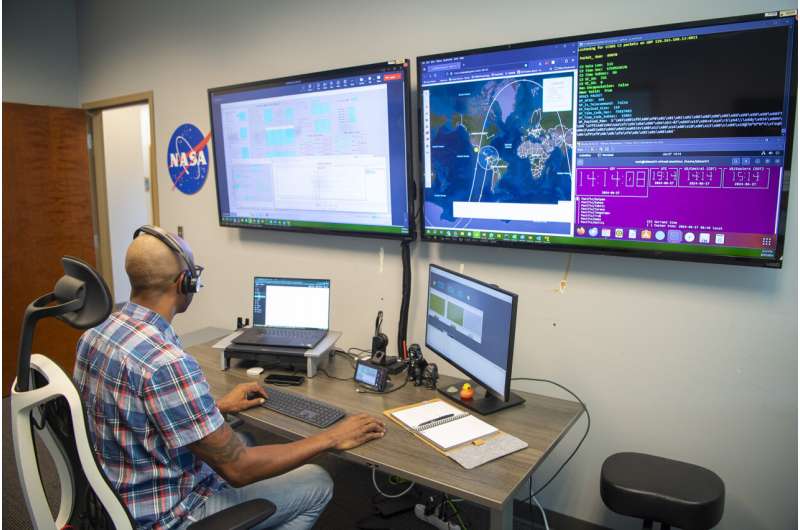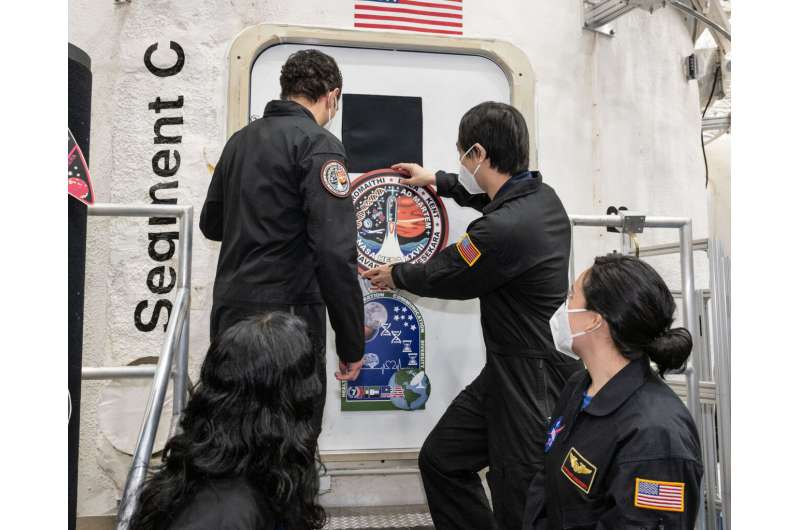SpaceX wins NASA contract to launch gamma-ray astronomy mission
Wednesday, 03 July 2024 04:44

NASA assessment suggests potential additional delays for Artemis 3 lunar lander
Wednesday, 03 July 2024 04:39

Europe's Ariane 6 rocket finally ready for liftoff
Tuesday, 02 July 2024 22:02 Europe's new Ariane 6 rocket is set for its first-ever launch next week, carrying with it the continent's hopes of regaining independent access to space and fending off soaring competition from Elon Musk's SpaceX.
After four years of delays, the European Space Agency's (ESA) most powerful rocket yet is finally due to blast off from Europe's spaceport in Kourou, French Guiana, at 3:00 pm (180
Europe's new Ariane 6 rocket is set for its first-ever launch next week, carrying with it the continent's hopes of regaining independent access to space and fending off soaring competition from Elon Musk's SpaceX.
After four years of delays, the European Space Agency's (ESA) most powerful rocket yet is finally due to blast off from Europe's spaceport in Kourou, French Guiana, at 3:00 pm (180 Japan succesfully launches H3 next-gen rocket with new observation satellite
Tuesday, 02 July 2024 22:02 In its third attempt in more than a year, the Japan Aerospace Exploration Agency successfully launched Monday its new H3 rocket carrying with it this time an observation satellite intended to monitor damage on Earth from natural disasters.
"Today, the payload, Daichi-4, was deployed into its operational environment - space - and has commenced its mission," Hiroshi Yamakawa, JAXA's pre
In its third attempt in more than a year, the Japan Aerospace Exploration Agency successfully launched Monday its new H3 rocket carrying with it this time an observation satellite intended to monitor damage on Earth from natural disasters.
"Today, the payload, Daichi-4, was deployed into its operational environment - space - and has commenced its mission," Hiroshi Yamakawa, JAXA's pre Ahead of Ariane 6 launch, what are the other big rockets?
Tuesday, 02 July 2024 22:02 Europe's new Ariane 6 rocket is due to blast off for the first time next week, but it will launch into a quickly changing market for heavy space launchers increasingly dominated by SpaceX.
Here are some of the other big rockets competing for the lucrative job of hauling satellites and other missions into space.
- Ariane 6 -
The first flight of the European Space Agency's biggest roc
Europe's new Ariane 6 rocket is due to blast off for the first time next week, but it will launch into a quickly changing market for heavy space launchers increasingly dominated by SpaceX.
Here are some of the other big rockets competing for the lucrative job of hauling satellites and other missions into space.
- Ariane 6 -
The first flight of the European Space Agency's biggest roc SpaceX launches U.S. spy satellites from Vandenberg
Tuesday, 02 July 2024 22:02 SpaceX launched spy satellites for the United States from Vandenberg Space Force Base on Friday night.
The Falcon 9 rocket lifted off from Space Launch Complex 4 East at the opening of a two-hour window, 8:14 p.m. PDT.
The United States' National Reconnaissance Office described the classified mission as "the second launch of NRO's proliferated architecture, delivering critical sp
SpaceX launched spy satellites for the United States from Vandenberg Space Force Base on Friday night.
The Falcon 9 rocket lifted off from Space Launch Complex 4 East at the opening of a two-hour window, 8:14 p.m. PDT.
The United States' National Reconnaissance Office described the classified mission as "the second launch of NRO's proliferated architecture, delivering critical sp Arctic Satellite Broadband Mission Prepares for Launch
Tuesday, 02 July 2024 22:02 Space Systems Command's (SSC) two Enhanced Polar System Recapitalization (EPS-R) payloads, integrated with Space Norway's Arctic Satellite Broadband Mission (ASBM) vehicles, have arrived at Vandenberg Space Force Base, California. The satellites are set for final integration with the launch vehicle, targeting a dual launch as early as July.
The payloads and host vehicles received shipment
Space Systems Command's (SSC) two Enhanced Polar System Recapitalization (EPS-R) payloads, integrated with Space Norway's Arctic Satellite Broadband Mission (ASBM) vehicles, have arrived at Vandenberg Space Force Base, California. The satellites are set for final integration with the launch vehicle, targeting a dual launch as early as July.
The payloads and host vehicles received shipment China's Tianwen 2 Probe to Undertake Ambitious Asteroid and Comet Mission
Tuesday, 02 July 2024 22:02 China's Tianwen 2 probe is set to launch on a Long March 3B rocket in May 2025. This ambitious mission aims to return samples from a near-Earth asteroid and then explore a comet, marking a significant step in space exploration.
The probe's first target is the near-Earth asteroid 469219, also known as Kamo'oalewa in Hawaiian. Tianwen 2 will conduct remote sensing to identify potential landi
China's Tianwen 2 probe is set to launch on a Long March 3B rocket in May 2025. This ambitious mission aims to return samples from a near-Earth asteroid and then explore a comet, marking a significant step in space exploration.
The probe's first target is the near-Earth asteroid 469219, also known as Kamo'oalewa in Hawaiian. Tianwen 2 will conduct remote sensing to identify potential landi Mapping Mars with Open Science Tools
Tuesday, 02 July 2024 22:02 Mars rovers uncover new discoveries through careful decision-making by scientists. The Mars 2020 mission focuses on Jezero Crater's geology and searching for signs of ancient microbial life with the Perseverance rover. Researchers at NASA's Jet Propulsion Laboratory (JPL) in Southern California utilized innovative mapping methods to guide both the rover and the Ingenuity helicopter, using open-s
Mars rovers uncover new discoveries through careful decision-making by scientists. The Mars 2020 mission focuses on Jezero Crater's geology and searching for signs of ancient microbial life with the Perseverance rover. Researchers at NASA's Jet Propulsion Laboratory (JPL) in Southern California utilized innovative mapping methods to guide both the rover and the Ingenuity helicopter, using open-s University of Michigan wins NASA's lunar lander challenge award
Tuesday, 02 July 2024 22:02 The University of Michigan may have topped its college football title with an out-of-this-world science challenge win.
NASA named its team as the winner of its 2024 Human Lander Challenge at a forum in Huntsville, Ala., on Friday.
Michigan beat out 11 other universities throughout the United States who made presentations in front of NASA and space industry experts addressing the
The University of Michigan may have topped its college football title with an out-of-this-world science challenge win.
NASA named its team as the winner of its 2024 Human Lander Challenge at a forum in Huntsville, Ala., on Friday.
Michigan beat out 11 other universities throughout the United States who made presentations in front of NASA and space industry experts addressing the Robotic rover could support astronauts on moonwalks
Tuesday, 02 July 2024 18:52
Robotic companions are a mainstay of sci-fi series everywhere. From R2D2 to Johnny 5, these characters typically have a supporting role in the story and are helpful to their human companions. But what if they were integral to the humans in the story? So much so that they couldn't live without their robotic compatriots?
That's the idea behind Biobot, which was given a NIAC grant in 2018—why not use a robotic companion to carry supporting equipment on human extravehicular activities (EVAs) on other planets?
If you watch the footage from the Apollo missions, you can see how awkward it is for the astronauts to bend over to pick things up. Also, these extraordinarily naturally fit and gifted people seem to fall over an awful lot, given how coordinated they are on Earth. That's probably because of a 61 kg pack on their back that is helping to keep them alive.
Each moonwalker had to carry a life support system on their suit to maintain conditions inside the suit that allowed them to breathe and not cook to death.
NASA Stennis achieves primary success for historic in-space mission
Tuesday, 02 July 2024 14:33
NASA's Stennis Space Center and partner Sidus Space Inc. announced primary mission success July 2 for the center's historic in-space mission—an autonomous systems payload aboard an orbiting satellite.
"Our ASTRA (Autonomous Satellite Technology for Resilient Applications) payload is active and operational," NASA Stennis Center Director John Bailey said. "This is an incredible achievement for Stennis, our first-ever in-space mission flying on a new state-of-the-art satellite.
Mission success: HERA crew successfully completes 45-day simulated journey to Mars
Tuesday, 02 July 2024 14:33
Four dedicated explorers—Jason Lee, Stephanie Navarro, Shareef Al Romaithi, and Piyumi Wijesekara—just returned from a 45-day simulated journey to Mars, testing the boundaries of human endurance and teamwork within NASA's HERA (Human Exploration Research Analog) habitat at Johnson Space Center in Houston. Their groundbreaking work on HERA's Campaign 7 Mission 2 contributes to NASA's efforts to study how future astronauts may react to isolation and confinement during deep-space journeys.
Throughout their mission, the crew conducted operational tasks and participated in 18 human health studies. These studies focused on behavioral health, team dynamics, and human-system interfaces, with seven being collaborative efforts with the Mohammed Bin Rashid Space Centre (MBRSC) of the United Arab Emirates (UAE) and the European Space Agency.




